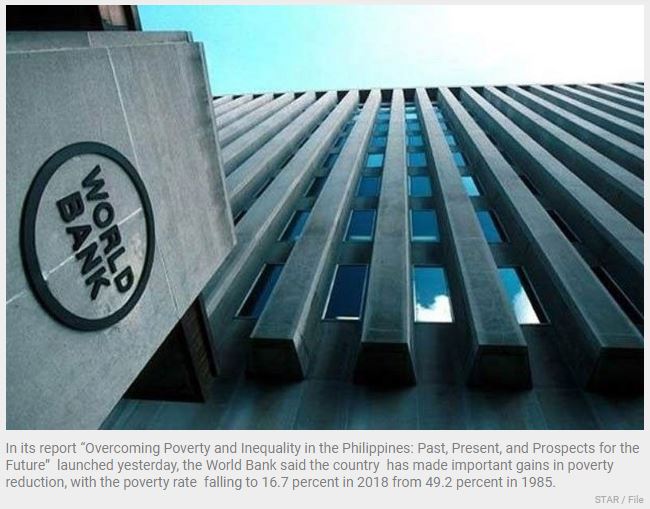Philippines income inequality among highest in East Asia – World Bank
MANILA, Philippines — The Philippines has made gains in reducing poverty, but it is among the countries with the highest income inequality in East Asia, which the World Bank said could be addressed through policies that build resilience and promote equal access to opportunities.
In its report “Overcoming Poverty and Inequality in the Philippines: Past, Present, and Prospects for the Future” launched yesterday, the World Bank said the country has made important gains in poverty reduction, with the poverty rate falling to 16.7 percent in 2018 from 49.2 percent in 1985.
“By 2018, the middle class had expanded to nearly 12 million people and the economically secure population had risen to 44 million,” the multilateral lender said.
Income inequality, however, is still high, with the country’s income Gini coefficient, which measures the distribution of income across a population, at 42.3 percent in 2018, one of the highest income inequality rates in East Asia, the World Bank said.
“The wealthiest one percent of earners capture 17 percent of national income; all those in the bottom 50 percent collectively receive only 14 percent,” the World Bank said.
It also said the COVID-19 pandemic has reversed the country’s gains in reducing poverty and inequality, with the national poverty rate rising to 18.1 percent last year and unemployment rising in industries that require in-person work.
As the Philippines has a long-term vision of having a society where no one is poor under the AmBisyon Natin 2040, the World Bank said reducing inequality and promoting inclusion are vital to the country’s national development.
“The Philippines aims to become a middle-class society free of poverty by 2040, but we know from global experience that no country has managed to make this transition while maintaining high levels of inequality,” said Ndiamé Diop, World Bank country director for Brunei, Malaysia, the Philippines and Thailand.
“Inequality of opportunity and low mobility across generations waste human potential and slow down innovation, which is crucial for building a competitive and prosperous economy that will in turn improve the well-being and quality of life of all Filipinos,” he said.
The World Bank said inequality in the Philippines starts even before birth, particularly with maternal nutrition and health during pregnancy, and is perpetuated over the life cycle.
Differences continue into childhood, with disparities in access to health care, proper nutrition, safe drinking water, sanitation and quality education determining the development of human capital.
“Inequality shapes outcomes later in life, such as employment opportunities and income, which in turn influence how much support adult Filipinos are able to provide for their children to help maximize their potential,” World Bank senior economist Nadia Belhaj Hassine Belghith said.
To reduce inequality, the World Bank said the government’s policies could be structured around the following: healing the pandemic’s scars and building resilience, preparing for inclusive recovery, and promoting greater equality of opportunity.
Source: https://www.philstar.com/business/2022/11/25/2226221/philippines-income-inequality-among-highest-east-asia-world-bank


 English
English




